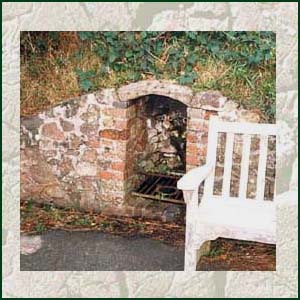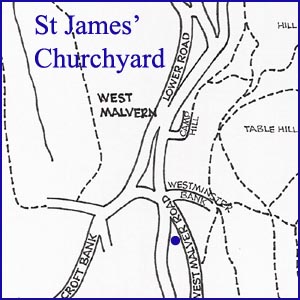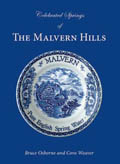
| 
|


St James' Churchyard Spout
NGR 76365 46079
Site Number: C32
By Bruce Osborne and Cora Weaver (C) 2012
Area 3. North Malvern Springs and Wells
Malvern Hills, England
Description: a recess with a spout and basin, the latter at ground level.
This spout is tucked into a niche in the churchyard wall adjacent to the main road. The water in the basin probably originates from the Westminster Bank spring. Nearby is the grave of Peter Mark Roget (1779-1869) which, unusually, is lying north/south rather than east/west. His famous thesaurus of English words, first published in 1850, classified words according to their meaning.
In 1793, Dr. Thomas Beddoes MD (1760-1808), English physician and scientific writer at Oxford University decided to settle in Clifton and the Hotwell Spa, with a view to establishing a Pneumatic Institute for the treatment of diseases by inhalation. A young doctor helping Beddoes with the outpatients was Peter Mark Roget, later author of the Thesaurus. The apparatus was constructed by James Watt, Scottish inventor and mechanical engineer, and financed by Mr. Lambton, and Thomas Wedgwood, son of Joseph Wedgwood the potter, who had all moved to Clifton. In 1798, the institution was opened in Dowry Square, at that time the residential heart of Hotwell Spa, and later in Broad Quay. Dr. Beddoes's work is considered important for having fostered the genius of young Humphry Davy, Superintendent of the Institution, who there discovered the properties of nitrous-oxide gas in 1799, otherwise known as laughing gas, and the forerunner of modern anaesthetics.[1]
Illustrations:
1. St James' Churchyard Spout.
2. St James' church and churchyard 1932.
Footnotes:
[1] Bruce Tyldesley, The Clifton Spa Pump Room (2010) see Ch.16. - click logo below.

Website: Click Here
SUPPLEMENTARY INFORMATION

Celebrated Springs of
THE MALVERN HILLS
 A definitive work that is the culmination of 20 years researching the springs and wells of the Malvern Hills, published by Phillimore. This is the ideal explorers guide enabling the reader to discover the location and often the astounding and long forgotten history of over 130 celebrated springs and wells sites around the Malvern Hills. The book is hard back with dust cover, large quarto size with lavish illustrations and extended text. Celebrated Springs contains about 200 illustrations and well researched text over a similar number of pages, together with seven area maps to guide the explorer to the locations around the Malvern Hills. It also includes details on the long history of bottling water in the Malvern Hills.
A definitive work that is the culmination of 20 years researching the springs and wells of the Malvern Hills, published by Phillimore. This is the ideal explorers guide enabling the reader to discover the location and often the astounding and long forgotten history of over 130 celebrated springs and wells sites around the Malvern Hills. The book is hard back with dust cover, large quarto size with lavish illustrations and extended text. Celebrated Springs contains about 200 illustrations and well researched text over a similar number of pages, together with seven area maps to guide the explorer to the locations around the Malvern Hills. It also includes details on the long history of bottling water in the Malvern Hills.
Written by Bruce Osborne and Cora Weaver, this book is available on-line for £15.00 (delivered UK) - click Malvern Bookshop on the green panel top left. Alternatively send a cheque payable to Cora Weaver with your name and address to 4 Hall Green, Malvern, Worcs. WR14 3QX.
1) TOPOGRAPHICAL LOCATION:
Malvern Hills - arguably Britain's original National Park
2) LANDSCAPE:
Rural Village3) INFORMATION CATEGORY:
A Spring, Spout, Fountain or Holy Well Site4) MALVERN SPRING OR WELL SITE DETAILS:
Site with Malvern Water4 SPLASHES - Well Worth Finding

5) GENERAL VISITOR INFORMATION:
Access On FootFree Parking Nearby
Accessible All Year



